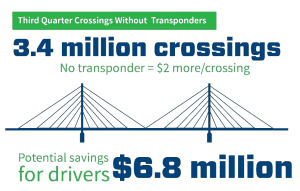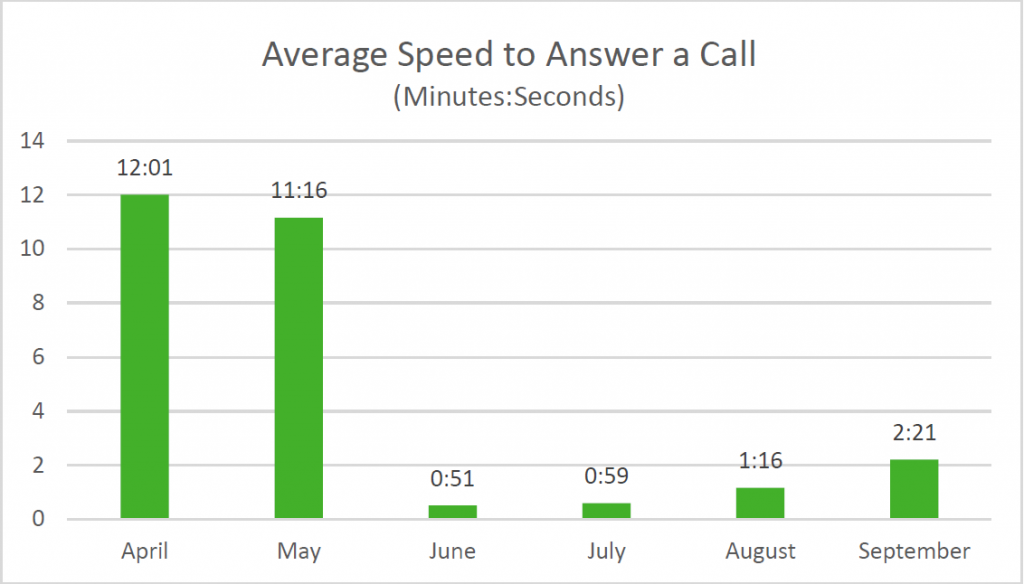Millions could be saved by opening prepaid accounts
The third quarter of tolling on three bridges connecting Louisville and Southern Indiana saw a steady number of crossings, but no significant growth in the number of drivers using transponders to cross the tolled bridges. There were more than 7.7 million crossings of the three tolled bridges in July, August and September. On average, 61 percent of weekday drivers used transponders while crossing the tolled bridges.
“Tolling has been in place for nearly a year, and it’s important all drivers understand that crossing a tolled bridge with a prepaid account and transponder will save them money, no matter how often they use the bridges,” said Megan McLain, innovative finance manager with the Kentucky Transportation Cabinet. “The cost savings are substantial.”
In the third quarter, more than one million crossings were made each month without a transponder. A driver saves $2 per crossing when using a prepaid account and transponder. Drivers could have saved nearly $7 million with prepaid accounts and transponders.

“A transponder is the fastest, easiest and most cost-effective way for drivers to pay the tolls they owe,” said Scott Adams, Indiana Department of Transportation director of tolling for the Ohio River bridges. “It’s also the fastest and easiest way for the states to collect tolls, which is why drivers with transponders and prepaid accounts pay the lowest rates. If a driver has a RiverLink account in good standing and a transponder, there’s no need for an invoice.”
A transponder is a small electronic device placed inside the front windshield of a vehicle, and is used to detect crossings on a tolled facility. When an overhead sensor reads a transponder, the lowest toll rate is deducted from a prepaid account.
Third Quarter Crossings
There were more than 7.7 million crossings on the three tolled bridges in the third quarter of the year, only a slight decrease from the second quarter, which included spring break and some of the summer travel season.

Third quarter crossings remained consistent on all three tolled bridges, the I-65 Abraham Lincoln Bridge, I-65 Kennedy Bridge and SR 265 Lewis and Clark Bridge.

There was only a slight increase in the number of drivers crossing tolled bridges with transponders. The average number of weekday drivers using transponders had climbed five percentage points since the first quarter of tolling.

The number of drivers who qualify for the frequent-user discount has remained consistent, averaging around 7,200 drivers per month.

The frequent-user discount is an automatic credit after 40 trips are posted on any of the three tolled bridges in a calendar month. The credit is 50 percent, and each additional trip that month is also discounted 50 percent.
The frequent-user discount is only for drivers in passenger vehicles with RiverLink personal accounts who maintain a positive balance. The frequent-user discount is per transponder, not per account.
RiverLink Accounts and Transponders
The number of RiverLink prepaid accounts and the number of RiverLink local transponders and RiverLink E-ZPass transponders requested continued to grow at a steady pace.
The number of RiverLink prepaid accounts increased nearly 10 percent in the third quarter to more than 137,000 accounts. More than 300,000 transponders had been requested to date.

For drivers without prepaid accounts and transponders, cameras capture an image of the license plate and an invoice is mailed to the registered owner of the vehicle. There’s no need for drivers to take any action until the invoice arrives.
While waiting for an invoice or after an invoice arrives, vehicle owners can contact RiverLink customer service by phone or in person, open a prepaid RiverLink account and receive lower toll rates. Current, outstanding trips will be reduced to the transponder rate. To receive the benefits of conversion, drivers must open a RiverLink account before the bill moves to the collection process.
Initial invoices are for tolls owed, and do not include any penalties. An invoice is mailed to the registered owner of the vehicle. It’s important the owner of the vehicle has his current address on file with the Bureau of Motor Vehicles and County Clerk’s Office, as required by law.
Customer Service
The average time to answer a call to RiverLink customer service dropped dramatically in the second quarter of the year, and those gains remained fairly consistent in the third quarter. Nearly 100,000 calls were received in the third quarter. The average time to answer a call to 855-RIV-LINK was less than a minute in July, just over a minute in August and just over two minutes in September.

Recent Additions
Automated Payment System and Online Tutorials
Thousands of people are using the automated phone system to make payments to their RiverLink accounts and to pay invoices. The automated payment option was added in May, allowing customers to pay an invoice over the phone without ever talking to a customer service representative. Nearly 100,000 payments were made with the automatic system in the third quarter.

Step-by-step tutorials for managing RiverLink accounts online were added to www.riverlink.com in the third quarter to assist customers in managing their accounts online. The guide offers step-by-step directions for everything from setting up a RiverLink account to adding auto-replenishment to an account to paying an invoice.
RiverLink Starter Kits
RiverLink started selling starter kits this summer, offering another option for purchasing transponders. The kit includes a RiverLink prepaid transponder and reload card. Drivers do not need to register their transponder or car to use the prepaid transponder. They simply purchase the kit, activate it at the store register and maintain a positive balance. Drivers can also convert to a registered RiverLink account to eliminate reloading fees and access additional services.

RiverLink starter kits are sold at all Speedway locations in Kentucky and Indiana, all Thorntons locations in Louisville and Jeffersonville and select Newcomb Oil locations in Kentucky.
Revenue to Date
Revenue numbers are preliminary for the third quarter. In the third quarter, $21.7 million was collected and split evenly between Indiana and Kentucky. An additional $2.8 million will be received from E-ZPass systems in other states (drivers who crossed the tolled Ohio River bridges with E-ZPass transponders from other states).
The billing cycle is still active, and additional money is being collected from vehicle owners who have received invoices.
Since the start of tolling on Dec. 30, 2016, more than $56.4 million has been collected and split evenly between the two states.
Revenue collected to date is in line with expectations, and both states are meeting their financial obligations for the Bridges Project. Toll revenue can only be used to meet financial obligations of the project and for operation and maintenance of the project area.

